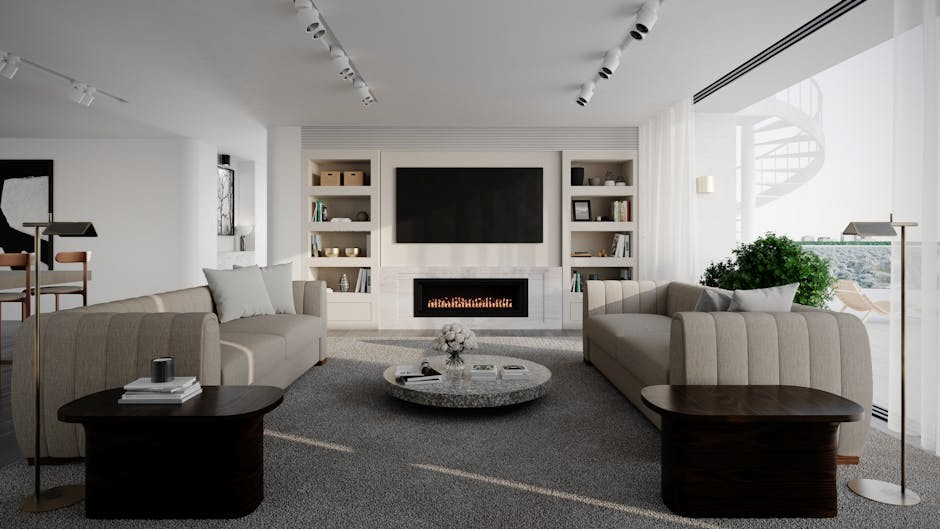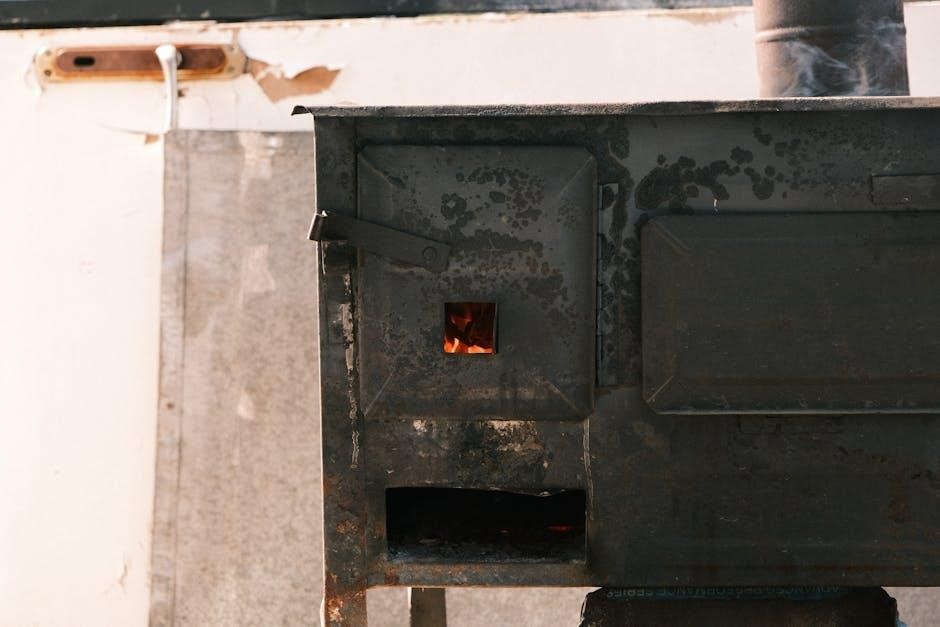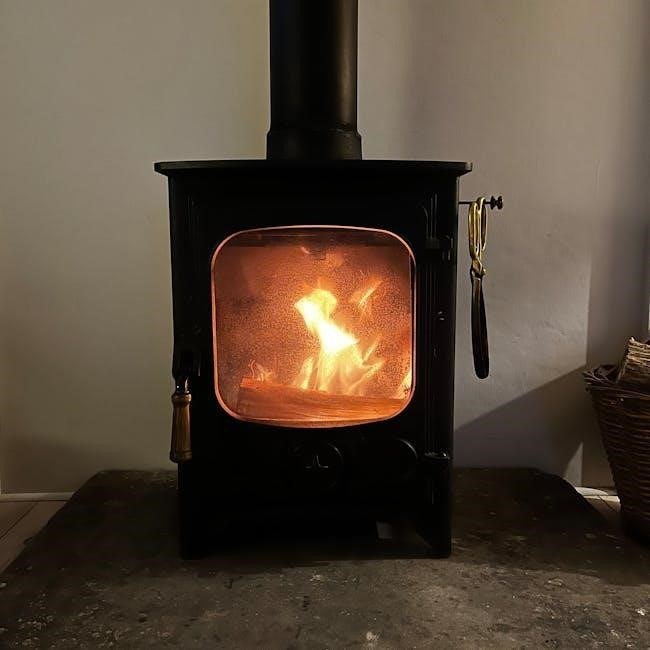Choosing the right fireplace insert size is crucial for efficiency‚ safety‚ and aesthetics. This guide helps you navigate key factors like room size‚ BTU needs‚ and installation requirements to ensure a perfect fit for your home.
Understanding the Importance of Proper Sizing
Proper sizing of a fireplace insert is essential for efficient heating‚ safety‚ and optimal performance. A correctly sized insert ensures your space is heated evenly while maintaining energy efficiency. An oversized unit may lead to poor airflow and reduced efficiency‚ while an undersized one may fail to heat the room adequately. Proper sizing also enhances safety by preventing overheating or inadequate ventilation. Accurate measurements and BTU calculations are critical to match the insert to your room’s dimensions and heating needs. Neglecting proper sizing can result in poor performance‚ increased energy costs‚ and potential safety hazards. Always prioritize precise measurements and consider factors like room layout‚ insulation‚ and local climate for the best results.

Key Factors to Consider When Choosing a Fireplace Insert
Room size‚ BTU requirements‚ fuel type‚ chimney height‚ and safety standards are critical factors to ensure optimal performance and efficiency of your fireplace insert.
Room Size and Layout
Room size and layout are essential for determining the appropriate fireplace insert size. A larger room requires more heat output‚ while smaller spaces need less. Measure the square footage and consider the room’s dimensions‚ including ceiling height. Open layouts may require a more powerful insert to distribute heat evenly. Additionally‚ the placement of furniture and doors can impact airflow and heat circulation. Assessing these factors ensures the insert provides efficient and consistent heating. Proper sizing also prevents overheating in smaller areas or insufficient warmth in larger spaces. Always measure the room thoroughly and compare it with the insert’s specifications for optimal performance.
Chimney Height and Ventilation
Chimney height and ventilation play a critical role in fireplace insert performance. A taller chimney improves draft‚ ensuring efficient combustion and proper venting of fumes. Measure the chimney’s height and inspect its condition to ensure it’s free from blockages like debris or nests. Proper ventilation is essential for safety and efficiency‚ as it prevents carbon monoxide buildup. The chimney’s height should align with the insert’s specifications to maintain airflow. Additionally‚ check for any damage or obstructions in the flue‚ as this can affect ventilation. Ensuring the chimney is in good condition and appropriately sized for the insert guarantees optimal functionality and safety. Regular maintenance and inspections are recommended to uphold ventilation efficiency and overall system performance.
Mantel and Hearth Dimensions
Mantel and hearth dimensions are vital when selecting a fireplace insert. Measure the mantel’s width and height to ensure the insert fits seamlessly. The hearth’s depth and width must also be considered to maintain proper clearance. Ensure the insert’s dimensions align with the mantel and hearth to preserve the fireplace’s structural integrity and aesthetic appeal. Additionally‚ verify that the hearth material can withstand the insert’s heat output. Proper measurements prevent modifications and ensure a safe‚ visually cohesive installation. Accurate dimensions also help in maintaining the fireplace’s original design while enhancing functionality. Always compare your measurements with the manufacturer’s specifications for a precise fit.
Clearance Requirements
Clearance requirements are essential for safe and efficient fireplace insert installation. Maintain adequate space between the insert and surrounding walls‚ flooring‚ and combustible materials. Measure clearance from the insert to nearby surfaces‚ ensuring it meets safety standards. Factors like the type of surrounding materials (e.g.‚ wood‚ drywall) influence required clearances. Typically‚ clearances range from 6 to 18 inches‚ depending on the insert type and local building codes. Use heat-resistant barriers if necessary. Always consult the manufacturer’s guidelines and local regulations to ensure compliance. Proper clearance prevents overheating‚ fire hazards‚ and damage to adjacent structures. Regular inspections are crucial to maintain safety and efficiency. Neglecting clearance requirements can lead to performance issues or safety risks‚ making it a critical factor in your fireplace insert installation.
Climate Considerations
Climate plays a significant role in selecting the right fireplace insert size. In colder climates‚ higher BTU outputs are necessary to heat larger spaces effectively‚ while milder climates may require smaller units. Ensure the insert’s heating capacity matches your region’s temperature demands. Additionally‚ consider moisture levels in humid climates‚ as they can affect the insert’s performance and durability. Proper ventilation is essential in areas with heavy rainfall or snow to prevent moisture buildup. Choose materials and designs suited to your local climate‚ such as rust-resistant coatings in coastal regions. Always check local regulations‚ especially those related to emissions and efficiency‚ to ensure compliance. By tailoring your choice to your climate‚ you can optimize performance‚ safety‚ and energy efficiency while meeting environmental standards.

Types of Fireplace Inserts
Fireplace inserts come in various types‚ each offering distinct benefits. Wood-burning inserts provide traditional ambiance‚ while gas and pellet models offer convenience and efficiency‚ catering to different needs.
Wood-Burning Fireplace Inserts
Wood-burning fireplace inserts are a popular choice for those seeking a traditional fire experience. They are designed to fit into existing masonry fireplaces‚ enhancing efficiency while maintaining the classic charm of wood burning. These inserts are typically constructed with durable materials like cast iron or steel‚ ensuring long-lasting performance. One of the key advantages of wood-burning inserts is their ability to provide a cozy‚ authentic ambiance‚ making them ideal for homeowners who value the aesthetic and sensory experience of a wood fire. However‚ they require proper ventilation and regular maintenance to ensure safety and efficiency. Additionally‚ recent regulations may affect the types of fuels you can burn‚ so it’s important to check local guidelines before installation. Proper sizing is also crucial to maximize heating potential and minimize environmental impact.
Direct Vent Gas Fireplace Inserts
Direct vent gas fireplace inserts offer a convenient and efficient alternative to wood-burning models. They utilize a sealed combustion system‚ drawing air from outside the home and venting gases directly through a wall or roof‚ ensuring safe and efficient operation. These inserts are known for their consistent heat output and low emissions‚ making them an environmentally friendly option. They are also relatively low maintenance‚ as they don’t produce ash or soot like wood-burning inserts. Direct vent gas inserts are controlled by a remote or wall switch‚ providing ease of use and adjustable heat levels. Available in a variety of styles‚ they can complement both modern and traditional home décor. Their energy efficiency and ease of installation make them a popular choice for homeowners seeking a hassle-free heating solution.
Pellet Fireplace Inserts
Pellet fireplace inserts are an eco-friendly and efficient option for homeowners. These inserts burn compressed wood pellets‚ which produce minimal emissions and are considered a sustainable fuel source. They offer consistent heat output and can be controlled via thermostats or remote controls for precise temperature management. Unlike wood-burning inserts‚ pellet inserts require less maintenance as they produce less ash and soot. They are also cost-effective‚ as pellets are often cheaper than natural gas or electricity. Pellet inserts are available in various designs‚ allowing them to blend seamlessly with different home styles. Additionally‚ they are environmentally friendly‚ producing fewer pollutants compared to traditional wood fires. This makes them an excellent choice for those seeking a greener‚ efficient heating solution without compromising on comfort or aesthetics.

Measuring Your Fireplace for an Insert
Accurate measurements of the fireplace opening‚ back wall‚ and depth are essential to ensure a proper fit for your insert. Measure height‚ width‚ and depth precisely for the best results.
Measuring the Fireplace Opening
Start by measuring the height and width of the fireplace opening. Use a tape measure to record both dimensions accurately. Ensure the tape is level and straight for precise readings. Note that the opening’s shape‚ whether rectangular or arched‚ may require additional measurements. For arched openings‚ measure the widest and tallest points. Record these measurements to compare with the insert’s specifications. Accurate dimensions are critical to ensure the insert fits correctly and functions efficiently. Always double-check your measurements to avoid errors during installation. Proper fit ensures safety‚ optimal performance‚ and a seamless integration with your existing fireplace. This step sets the foundation for a successful installation process.
Measuring the Back Wall of the Fireplace
Next‚ measure the back wall of the fireplace to ensure the insert fits properly. Use a tape measure to record the height and width of the back wall. If the back wall is uneven or angled‚ take multiple measurements to find the smallest dimensions; This step is crucial for determining the maximum size of the insert that can fit without causing installation issues. Pay attention to any obstructions‚ such as bricks or mortar‚ that could affect the fit. Accurate measurements of the back wall ensure the insert aligns correctly and maintains proper clearance. This step is essential for both safety and performance‚ as improper fit can lead to inefficient heating or potential hazards. Always double-check your measurements to ensure accuracy. This ensures a secure and effective installation. Proper fit guarantees optimal functionality and safety.
Measuring the Depth of the Fireplace
Measuring the depth of the fireplace is essential to ensure the insert fits properly and functions efficiently. Use a tape measure to determine the distance from the back wall to the front edge of the fireplace opening. This measurement helps identify how far the insert can extend into the space without obstructing airflow or causing installation issues; If the fireplace has a particularly deep cavity‚ note this to ensure the insert’s depth accommodates it. Be aware of any obstructions‚ such as bricks or ledges‚ that could affect the fit. Accurate depth measurements ensure the insert sits correctly‚ maintaining proper clearance and ventilation. This step is vital for both performance and safety‚ as improper depth can lead to inefficiency or potential hazards. Always double-check your measurements to ensure a precise fit. This ensures the insert operates effectively and safely.
Inspecting the Flue
Inspecting the flue is a critical step in preparing for a fireplace insert installation. Ensure the flue is free from blockages‚ such as debris‚ soot‚ or animal nests‚ which can obstruct airflow and create safety hazards. Use a flashlight and mirror to examine the flue’s interior‚ especially the upper sections. Check for cracks‚ damage‚ or gaps in the flue lining‚ as these can compromise efficiency and safety. Measure the flue’s diameter to ensure it matches the insert’s venting requirements. A properly functioning flue is essential for venting gases and maintaining proper draft. If you find significant damage or blockages‚ consider hiring a professional to clean or repair the flue before installing the insert. A well-maintained flue ensures efficient performance and safety for your fireplace insert. Regular inspections help prevent issues and extend the lifespan of your system.

Calculating BTU Requirements
Assess your space’s size‚ insulation‚ window count‚ and climate to determine the BTU needed for efficient heating‚ ensuring optimal performance from your fireplace insert.
How to Determine the BTU Needed for Your Space
To determine the BTU needed for your space‚ start by calculating the square footage of the room. Measure the length and width of the room and multiply them together. Next‚ consider the insulation quality‚ window size‚ and the number of windows‚ as these factors affect heat loss. If your space has high ceilings‚ adjust the BTU requirement accordingly. Additionally‚ climate plays a significant role; colder climates require higher BTUs. Use a BTU calculator or consult a professional to ensure accurate measurements. Proper sizing ensures efficient heating and avoids energy waste. Remember‚ oversized units can lead to higher costs‚ while undersized units may not heat adequately. By carefully assessing these factors‚ you can select a fireplace insert that meets your heating needs effectively.

Installation Considerations
Proper installation ensures safety and efficiency. Measure the site‚ assess fuel type‚ and ensure ventilation. Hiring a professional is recommended to comply with regulations and avoid hazards.
Measuring the Installation Site
Accurate measurements are essential for a successful installation. Begin by measuring the height‚ width‚ and depth of the fireplace opening to ensure the insert fits seamlessly. Use a tape measure to record these dimensions precisely‚ as they will guide your selection. Next‚ assess the surrounding area‚ including the hearth and mantel‚ to ensure there is enough clearance for the insert and any additional components. Consider the space where the insert will be placed‚ ensuring it aligns with the flue and ventilation system. Proper alignment is crucial for safe and efficient operation. Double-check all measurements against the manufacturer’s specifications to avoid any discrepancies. Taking the time to measure carefully will ensure a proper fit and prevent installation issues down the line.
Assessing Fuel Type and Ventilation Needs
Choosing the right fuel type for your fireplace insert is vital‚ as it impacts both performance and installation requirements. Wood-burning inserts require a properly functioning flue to vent harmful gases‚ while gas inserts need a direct vent system for safe operation. Pellet inserts also require specific ventilation setups to ensure efficiency. Assessing your ventilation needs involves evaluating your chimney’s condition‚ height‚ and compatibility with the insert type. Proper ventilation ensures safety by preventing carbon monoxide buildup and maintains heating efficiency. Consider consulting manufacturer guidelines to match your fuel type with the appropriate venting system. Additionally‚ local building codes may dictate specific requirements‚ so it’s essential to verify compliance. Ensuring the right fuel and ventilation combination will optimize your insert’s performance and ensure a safe‚ enjoyable heating experience.
Ensuring Proper Ventilation
Proper ventilation is critical for the safe and efficient operation of a fireplace insert. A well-ventilated system prevents the buildup of harmful gases like carbon monoxide and ensures complete combustion of fuel. For wood-burning inserts‚ a clear and unobstructed chimney flue is essential‚ while gas inserts require direct venting to the outside. Pellet inserts also need dedicated ventilation systems to handle exhaust. Regular inspections of vents and chimneys can identify blockages or damage‚ such as bird nests or creosote buildup‚ which must be addressed. Additionally‚ installing carbon monoxide detectors near the fireplace adds an extra layer of safety. Proper ventilation not only enhances performance but also protects your home and family from potential hazards. Always follow manufacturer guidelines and local regulations to ensure your ventilation system meets safety standards.
Hiring a Professional Installer
Hiring a professional installer is essential for ensuring your fireplace insert is installed safely and efficiently. A qualified technician will assess your space‚ verify measurements‚ and handle complex tasks like venting and fuel connections. They will also ensure compliance with local building codes and safety regulations. Proper installation prevents risks like carbon monoxide leaks or fires‚ while also optimizing performance. Look for installers certified by industry organizations‚ such as NFI (National Fireplace Institute)‚ and check reviews to verify their expertise. DIY installations can lead to safety hazards and void warranties‚ making professional installation a wise investment for long-term satisfaction and security. Always request a detailed estimate and ask about their experience with your specific insert type to ensure a seamless process.

Safety and Maintenance
Regular inspections of vents and burners ensure safe operation. Keep flammable materials away and schedule annual professional servicing to maintain efficiency and prevent hazards.
Safety Tips for Fireplace Inserts
Ensuring the safety of your fireplace insert is paramount. Always keep flammable materials like curtains‚ rugs‚ and furniture at least 3 feet away from the insert. Regularly inspect the venting system for blockages or damage‚ as obstructions can lead to dangerous carbon monoxide buildup. Never overload the insert with fuel‚ as this can cause overheating or fires. For wood-burning inserts‚ only use seasoned‚ dry wood to minimize creosote accumulation. Gas inserts should be checked for proper ventilation and functioning valves. Keep children and pets away from the insert while it’s in use. Store fuel and ashes in designated‚ fireproof containers. Finally‚ schedule annual professional inspections to ensure everything is in safe working condition. These precautions will help create a safe and enjoyable heating experience.
- Keep flammable materials at a safe distance.
- Inspect vents regularly for blockages.
- Avoid overloading the insert.
- Use proper fuel types.
- Store fuel and ashes safely.
- Schedule annual professional servicing.
Best Practices for Maintenance
Regular maintenance is essential to ensure your fireplace insert operates efficiently and safely. Start by cleaning the insert and surrounding areas after each use‚ removing ashes and soot. For wood-burning inserts‚ inspect the chimney annually for creosote buildup and have it cleaned professionally if necessary. Check the glass for damage or discoloration and replace it if compromised. Gas inserts require checking burner ports for blockages and ensuring proper ventilation. Inspect all electrical components and connections regularly. Store fuel in a dry‚ well-ventilated area away from living spaces. For pellet inserts‚ clean the auger and hopper frequently to prevent jams. Always refer to the manufacturer’s guidelines for specific maintenance recommendations tailored to your insert type. Consistent upkeep extends the lifespan of your insert and ensures optimal performance.
- Clean the insert and surrounding areas after each use.
- Inspect and clean the chimney annually for wood-burning models.
- Check glass for damage and replace if necessary.
- Ensure gas burner ports are clear and functional.
- Inspect electrical components and connections regularly.
- Store fuel properly to avoid moisture and contamination.
- Follow manufacturer guidelines for specific maintenance needs.
